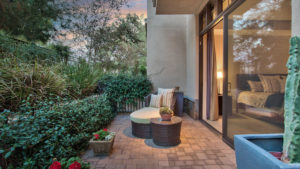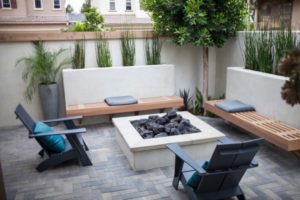As the summer season approaches, our thoughts turn to spending time outside.
If your outdoor space fills you with horror or even embarrassment, maybe it’s time to make this the year that you finally create your dream patio.
Use the following easy guidelines to help you plan your perfect new space.
How to Make Your Patio Accessible
Of course here at Miss M Design we put accessibility at the top of the list. If you plan to renovate or build anything around your home, making it accessible will ensure all your family and friends are able to enjoy it no matter what their abilities are.
#1) Clear space. Make sure you have lots of clear space for wheelchair travel and include several 60″/1.5m turning circles to allow a wheelchair to turn around in. This extra space will do double-duty as an area where the grand-kids can safely play and ride their tricycles.
#2) Indoor access. This door must be step-less and have a minimum opening of 36in/91cm for wheelchairs to access. Ensure it has as low a threshold (less than .5in/1cm) as possible to make it more comfortable to use while carrying full trays and for wheelchairs. TIP: You can purchase mini threshold ramps to help make them more accessible.
#3) Solid surface wide paths. These are required to join patio areas to each other and to your home. Level, smooth, solid surface paths that are at least 36”/91cm wide are best. Wood pathways look nice but they can become slippery in our wet west-coast conditions. Concrete is a great choice as it can be made seamless, stands up to years of use, and is non-slip. Pavers properly installed on a level surface can work well too and they come in many different sizes and are great to DIY. Design your paths curved, straight, or angled depending on the style of your home.
#4) Multi-levels. Be sure to join multi-level patio areas with ramps rather than stairs (or a combination of both). This will allow the whole patio area to be accessible to everybody as well as aiding in maintenance as you can easily wheel around a wheelbarrow.
Consider the purpose of your patio
Are you going to throw a lot of parties outside, use it as a family space, or would you rather a small, quiet, private patio just big enough for a couple of chairs and a bistro table? Determining the number of people you’ll be entertaining is an important first step.
Location, location, location
Where will your patio be located? Most patios are located beside the house as this provides easy access to a kitchen (and a bathroom).
If you have the yard space and the budget, you could consider a location further away, especially if you have some natural elements that would make a great feature or back-drop. Or you could consider building an additional smaller more intimate ‘getaway patio’ in this more remote location.
Walk around the property and check out vantage points and views to determine location and orientation. It’s important to note the sun’s trajectory throughout the day, the direction of the prevailing winds, and to keep in mind the location of neighbour’s homes.
Size matters
It’s easy to underestimate how big the patio should be. Don’t skimp on space. Remember when you’re designing the patio that it’s going to be populated with people, furniture, and installations like fire pits, fireplaces, outdoor kitchens, and hot-tubs.
How many people will you be entertaining? Will they be sitting on dining chairs around a dining table? Will there be a casual seating area with a sectional or sofa and chairs?
There’s no specific rule of thumb as to size, but if the site allows, design proportionately to the house.
The best shape
Remember to think about shape, which may be partially determined by the site. Curvy or straight, you should choose based on what works best with your home’s design. Shapes such as round, curvy and octagonal patios provide visual interest even when you’re not on the patio. Remember that you don’t just sit on the patio, you’ll see it from inside the house as well as from the yard.
What materials to use
Always choose building materials that complement the color and style of your house. In other words use more modern material like raw concrete or black metal with a contemporary home vs. a more traditional look such as flagstones and turned wood with a cottage. TIP: Of course with a deft hand, there are exceptions to every rule.
Natural materials like stone are popular but expensive. Concrete pavers provide a lower-cost option, and they come in a wide range of colors, textures, shapes, and sizes. TIP: Soften a large area of hard-scaping with plants and furniture.
Plan the landscaping
Planting-up the surrounding area of the patio can really make the space but be honest with yourself about whether you’re a plant lover or a low-maintenance person, and plant accordingly.
You can always do the hardscape first and add plant material later when it’s easier to visualize the space, but remember to allow enough space for the future trees and garden beds. Growing herbs in built-in planters or pots right on the patio will scent the air and be convenient to the indoor or outdoor kitchen. TIP: Remember to include a few conveniently placed water outlets for garden use.
The extras
- A fireplace or fire pit provides evening appeal and can physically warm up a space.
- A water feature adds ambiance and helps block noise from a busy street.
- Landscape and hardscape lighting around the patio will increase safety at night and is lovely after the sun goes down.
- A well-placed trellis can shade the hot afternoon sun and give privacy from a neighbor’s second story.
- Outdoor kitchens are growing in popularity and appliance showrooms are designating more space to showcasing them. TIP: Remember to include a few electrical outlets.
- Built-in raised planters or beds can define an area, be used as back-rests for built-in seats, and can be designed at a height that are easily accessible for people with limited mobility or for those who use a wheelchair.
Action Plan
Investing in an accessible patio will add value to your home in more ways than one. It will add monetary value to your home and enjoyment-value, as here in Victoria we are lucky enough to be able to enjoy our patios for many months each year.
So what are you waiting for? Start designing your perfect patio today to get the most enjoyment out of the upcoming season.





